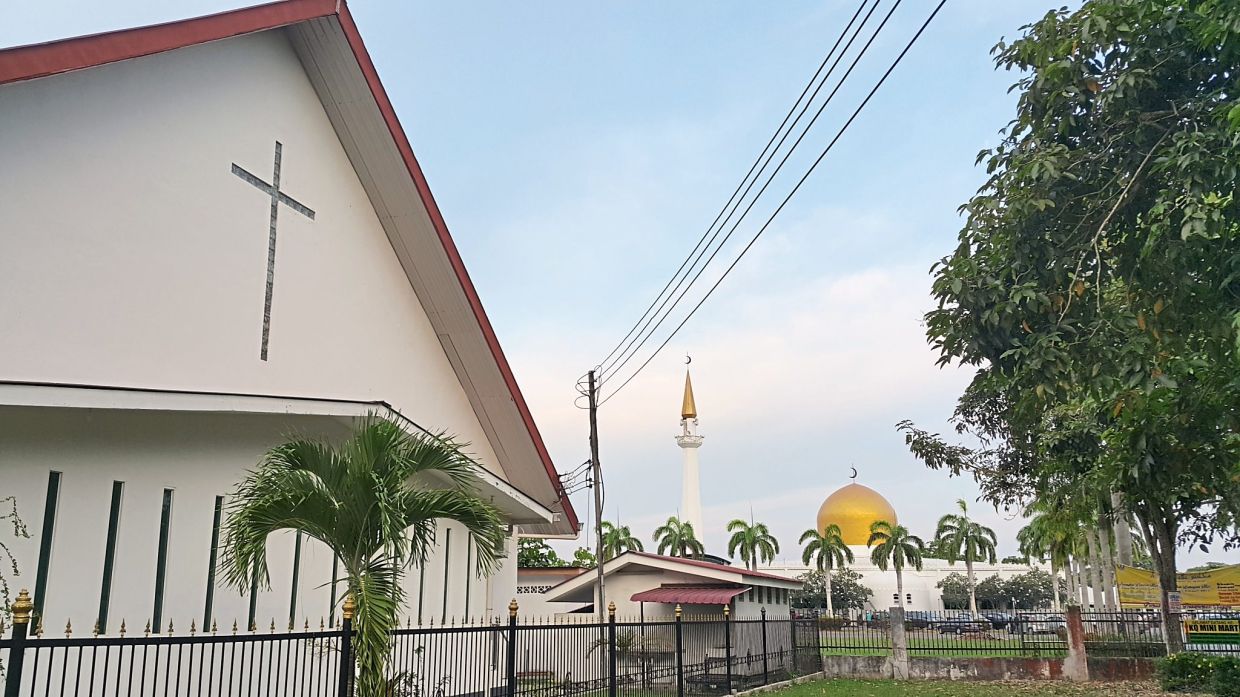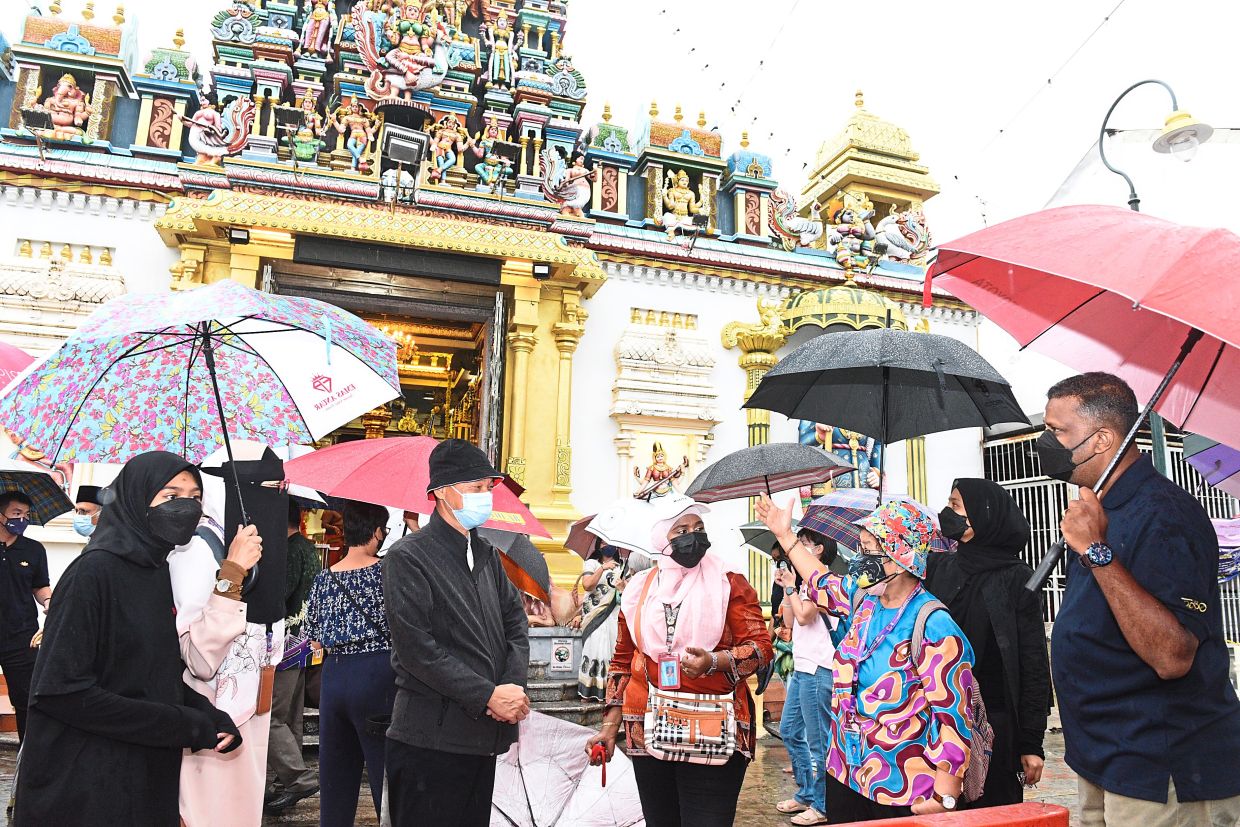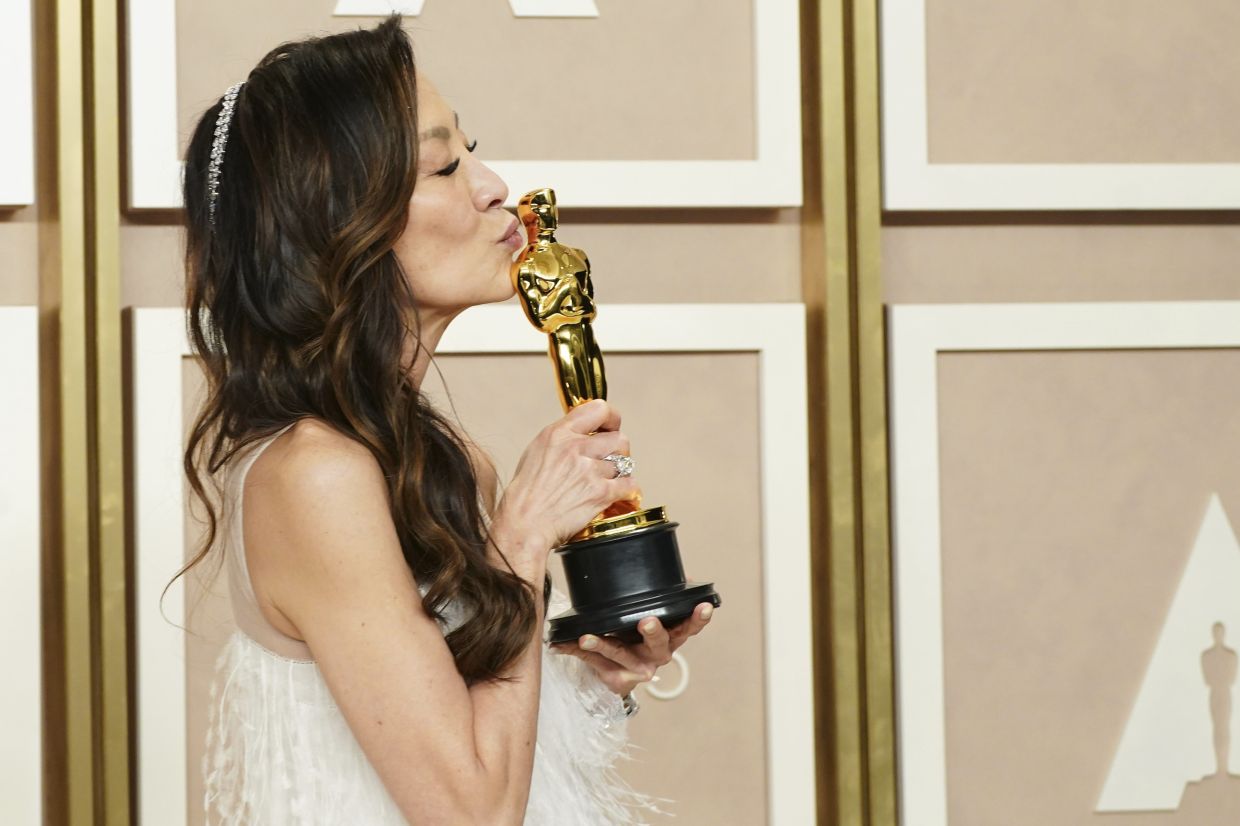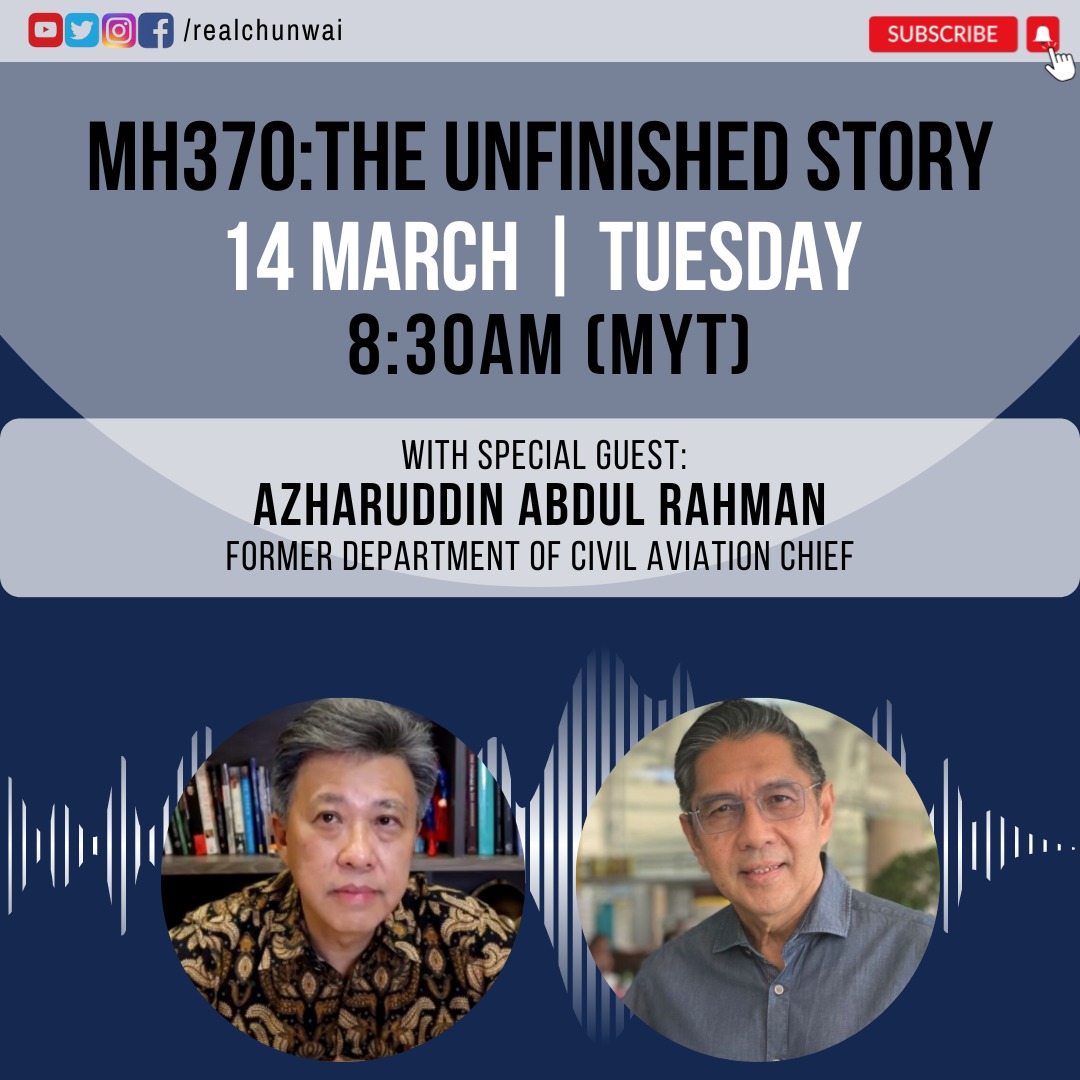

NO one is prepared to talk about what happened in Saudi Arabia where the Prime Minister had failed to meet King Salman Abdul Aziz Al Saud or Crown Prince Mohammed Salman Al Saud.
His political opponents have gone to town to demand an explanation from Datuk Seri Anwar Ibrahim for what they described as a royal snub.
They described it as a diplomatic fiasco and a waste of public funds as Anwar and his delegation could only manage to perform their umrah.
Given the political and diplomatic sensitivities involved, what happened has remained a mystery and, unfortunately, led to speculations and raised more questions.
But high-level sources said the PM would not have been so brazen as to proceed with the trip, described as an official trip in a Wisma Putra release, without a confirmation.
They said the green light had been given in a short notice and indeed the programme, which included an audience with His Majesty, had been approved.
‘’We received a third-person note. Surely, we would not go ahead without that,’’ said a senior source.
The third-person note is a term used by diplomats to describe an official letter of communication between an embassy and the Foreign Ministry.
The contents can be on anything but mostly bilateral matters, including visits involving leaders and especially heads of state.
The national media had caught wind of the visit to Saudi Arabia since last week but there was no confirmation until the late press release by Wisma Putra.
Many had initially thought that PMX – as Anwar, being Malaysia’s 10th Prime Minister, is popularly called – would make China the first country he would visit after Asean, where it is customary for a new government leader to visit every member country.
The sources said because of the late confirmation of the Saudi programme, the PM had to decide on short notice.
‘’If he didn’t take the slot, the worry would be that the Saudis would be offended.
“A quick call had to be made and the PM decided to proceed with it,’’ a diplomat said.
But the trip has unfortunately ended without a meeting with the two leaders, which would have been the highlight of the visit.
While it’s an embarrassment for Anwar, it has not been completely a waste as he managed to meet several Saudi business groups including Ajlan & Bros Holding Group and Wadi Makkah Knowledge Co – with memoranda of understanding signed with Malaysian partners, as well as meeting leaders from the Organisation of Islamic Conference (OIC) and Muslim World League.
The question now is what has gone wrong. The real powerhouse is the Saudi royalty, and not the country’s foreign ministry.
Given the importance of bilateral ties between Saudi Arabia and Malaysia, much must be done to improve relations, particularly at the personal level.
Total bilateral trade for 2022 amounted to a sum of US$10.26bil (RM45.89bil), which is an increase of 159.2% compared to US$4.23bil in 2021.
There are plenty of opportunities for Malaysians there, including the Neom city project, the Red Sea Project and the Saudi Green Initiative Project.
Neom is a planned smart city in Tabuk province in Saudi Arabia, where a ski resort is being planned and will contain cities, resorts and other developments.
Relations with Saudi are given priority and King Salman was also among the earliest to congratulate Anwar’s appointment as PM.
But as Anwar has said, there are issues that need to be negotiated and ironed out.
In 2018, the then Pakatan Harapan administration had order-ed the King Salman Centre for International Peace project set to be built in Putrajaya to be cancelled. The Saudi-backed anti-terrorism centre was launched in 2017 under Barisan Nasional during Datuk Seri Najib Razak’s premiership.
Pakatan’s then defence minister Datuk Seri Mohamad Sabu also ordered Malaysian troops serving in Saudi Arabia to maintain its neutrality in the region.
Malaysia had deployed troops to the kingdom in 2015 to facilitate the evacuation of Malaysians trapped in Yemen.
For the next few days, and maybe even during the state elections, Anwar’s Saudi trip will be used against him, where comparisons will be made with ex-PM Tan Sri Muhyiddin Yassin’s visit when he was accorded full honours.
But the attention will shift to Beijing over the next few days as Anwar makes the all-important official visit to China.
China has been Malaysia’s No. 1 trading partner for the last 14 years consecutively and both countries will celebrate 50 years of friendship next year.
Anwar is certain to get the proper red-carpet welcome and recognition for Malaysia in China.
For now, it looks like what happened in Saudi remains in Saudi without substantiated information.


Open outlook: In Sabah and Sarawak, it is perfectly normal to have family members practising different faiths within one household and houses of worship to be close to each other, like the Good Shepherd Church and Masjid An-Naim in Lutong, Miri, which even share car parks. – The Star
IT’S fair to suggest that National Unity Minister Datuk Aaron Ago Dagang is unknown to most members of the media, especially those in Kuala Lumpur.
He is almost non-existent in the news as he seldom issues media statements or calls for press conferences.
That is such a terrible waste of opportunity because the Sarawakian MP heads an important ministry. It should play a bigger role in boosting national unity, which is his ministerial job scope.
Certainly, lawmakers from Sabah and Sarawak are the best people to speak up for racial and religious issues because they don’t have the hang-ups ailing some politicians from the peninsula.
In these two states, it is perfectly normal to have family members practising different faiths within one household.
Attending ceremonies at a temple, church or mosque are perfectly ordinary since mixed marriages are common. These events can go from weddings to wakes.
Last week, Aaron Ago, the MP for Kenowit, slipped into news feeds when he reportedly blamed the media “for deliberately wanting to fan flames” on sensitive issues, particularly relating to race and religion.
The politician, described by those who know him as mild-mannered, apparently lost his composure when a reporter sought his comments on Jom Ziarah, an event to get youths to visit different places of worship.
He was said to have side-stepped the issue. Perhaps he had good intentions, which was to downplay the controversy and put an end to it.
However, his response wasn’t right. Instead, he issued a stern warning to media practitioners to quit acting like instigators, asserting that “it’s enough.”
If he was annoyed with the said reporter, he could’ve just said that he has no comments or would rather not prolong the controversy, and appeal to the media to stop carrying the comments of certain politicians.
Yes, politicians, not the media. The instigators are a clutch of politicians and some commentators on social media, too.
Anyone can air their opinions on social media, but they don’t represent the institution. It’s misguided, misdirected, misrepresented and ill-informed, if not uninformed.
In the words of national journalism laureate Tan Sri Johan Jaafar, he found it “totally unacceptable” that Aaron Ago would blame the media, saying the minister “should be more responsible in making such an accusation.”
The award-winning veteran journalist said the politician was “certainly barking up the wrong tree” and the recent commotions are caused by irresponsible politicians, not the media.
Aaron Ago would be doing his job if he had the gumption to reprimand the recalcitrant politicians for their outrageous remarks and statements, including rejecting gatherings that could cause disharmony.
He could have even suggested that visits to places of worship would be under his ministry – and perhaps not the Youth and Sports Ministry – or perhaps organised jointly with the Minister of Religious Affairs’ office, to ensure everyone is involved.
Some guidelines would be good to ensure that these places of worship, regardless of the religions, are respected when visitors go there, such as dress codes and self-conduct.
I’m not sure if Aaron Ago is aware that the mainstream media exercises a great deal of restraint in its reporting. It’s not self-censorship, but we understand our role in a multi-ethnic and diverse Malaysia.
Johan added, the “current spike in racial tensions is the result of politicians fanning the flames for their own insidious purpose.
“Please stop blaming the messenger. Do not condemn the media to avoid blame for their own missteps, oversights, and mistakes.”
Unfortunately, after 100 days of the Anwar administration, there are still ministers who’ve yet to surface to meet the media.
While many have had press conferences, the media has intimated its impression to the Prime Minister’s Office that some ministers seem to be shying away from it.
Perhaps they’re unsure of how they should handle the press, especially the new ministers, while some may think there’s no need for them to cosy up to journalists, and that it’s sufficient to merely issue statements via their Facebook page.
Politicians and the media have a love-hate relationship, but lawmakers are actors, so they must watch their words.
Don’t just blame the media yet lack the courage to take on political opponents who harp on race and religion.
WHILE some of our pathetic politicians have been busy blowing a lot of hot air by shamelessly exploiting race and religion, a different kind of sound was heard at the Putra World Trade Centre last week.
Singer Datuk Sheila Majid’s beautiful music played at a sold-out concert there.
She is probably the only singer here who can sell out a concert and command a multiracial audience.
It was so touching hearing Sheila’s fans singing along to every one of her hit songs, and how they knew every line of the lyrics.
Almost half of her back-up musicians were non-Malays such as Mac Chew and Jenny Chin, her collaborators who have accompanied her since she started singing.
They were still there last week at the show.
In her own words, they were there with her in the high and low points of her singing career.
The large presence of non-Malays at her Big Band Live concert is proof of how popular she is, and that music is universal.
Here’s the most important point – she sang her songs, which are all in Bahasa Malaysia. But the crowd, mostly urbanites, had no issue that she used mostly English to speak to them.
The Queen of Jazz, as she is often called, dedicated a part of her concert to pay tribute to Jimmy Boyle.
Many present generation Malaysians have not heard of this composer and Sheila rightly put up a video dedication. It would not be wrong to describe the jazz pianist as a forgotten musician, but he composed over 300 songs including Putera Puteri.

United in music: Fans turned up in droves at Sheila Majid Big Band Live In concert, happy to be reunited with the Jazz Queen in Kuala Lumpur last week.
He wrote the Penang state anthem, Untuk Negeri Ku, and Kemegahan Negaraku, which was picked for the inaugural raising of the national flag on Aug 31, 1957.
Negaraku was not ready yet and Boyle’s composition was used for the historic occasion.
His name doesn’t appear in our history textbooks, unfortunately. I only knew about him as a young boy simply because he was a teacher at St Xavier’s Institution, long before I started schooling.
It was a lovely touch by Sheila, who also named the many Eurasian singers and musicians who played their part for Malaysia.
Then there were the personalities from Penang, who are no longer with us but should not be forgotten, like Ahmad Nawab, Ahmad Daud and of course, P. Ramlee.
At a time when politicians are trying to divide us, it is personalities like Sheila who have the ability to create a sense of belonging, trust and empathy. It is such a powerful tool.
As we sang and danced together at Dewan Merdeka, it was about what happens when Malaysia moves together to the same tune.
Who cares about the holier-than-thou religious politicians who lecture us against dancing and gender mixing but hypocritically turn stone deaf when it comes to fighting corruption and racism?
Shame on them.
Essentially, people everywhere are the same in heart and spirit, no matter what language we speak and sing.
Musicians and singers aside, our sports personalities have also shown how Malaysia can stand united as we cheer them in their battles to bring glory to the nation.
For example, badminton legend Datuk Lee Chong Wei once recalled that in the 2006 Malaysian Open, he saw a little Malay girl with her hands up in prayer for him, an Indian girl crying and a Chinese boy who was cheering so loud that the umpire told him to pipe down!
And we never got tired of seeing Chong Wei hugging his coach Datuk Misbun Sidek after his matches, regardless of whether he won or lost. They remain the most touching scenes ever.
And congratulations to Malaysian rock queen, Ella, who sold out 10,000 tickets for her 35th anniversary concert in 24 hours.
Certainly, you have Malaysia Standing in the Eyes of the World through your songs.
To all these music and sports legends, such as Datuk David Arumugam, Datuk DJ Dave, Jay Jay, Datuk Soh Chin Aun, Datuk Santokh Singh, Datuk Nicol David, and many others, thank you for uniting Malaysians. Thanks for the memories.
To the dreadful politicians who pit Malaysians against each other, shame on you!
TAR UMT is a story of sacrifice, self-reliance and dedication, and proof that when you give back to society, you also reap the rewards of your goodwill.
IT has been a lengthy five-decade journey for Kolej Tunku Abdul Rahman to attain the status of a full-fledged university, but its new branding has changed the lives of over 300,000 alumni.
It started as a modest community college in 1969, then became a university college in 2013 and finally now, is Tunku Abdul Rahman University of Management and Technology (TAR UMT).
The story of TAR UMT is about the founders, the community and the students who have benefitted from this institute of education. It’s a story of sacrifice, self-reliance and dedication.
But what tugged at my heartstrings most are the accounts of loan recipients who came from financially hard-pressed families.
Heart-warming narratives abound and one only needs to look through the many interviews that have been recorded.
There is Ilham Emir Mohamed Akif Emir, who enrolled in a multimedia design course around the time her parents had stopped working. She was given a loan, which she used to buy a laptop to help her in her course work.
Gan Wei Kang, who was studying for a degree in communications in advertising, was having problems getting a student loan, but help from the campus eased his course and living expenses.
Enrique Ng, who studied marketing, couldn’t afford his first semester fees, so he had to work part time, but the loan lightened his burden.
Lai Kah Mun, who majored in information technology, and her sister studied at the college while their parents struggled to pay for their expenses, but the loan allayed their worries.
If there’s a story of how so little could go so far, then that tale belongs to Thilaganathan Naidu, who did his A-levels at the then Kolej TAR (KTAR), and went on to obtain a scholarship via the college to study at the Lingnan University in Hong Kong. However, his study loan was less than RM9,000 then, and yet, he made it go the mile.
In a video presentation, Thila, who now works as a financial analyst for Bloomberg, spoke of how the loan had helped him.
But what’s most remarkable is that the repayment rate from this interest-free loan is almost 99%.
There’s nary a complaint of outstanding or late payments, or worst, complete non-payment.
The maximum value of the loan award for each academic year is RM12,000 for foundation year students, RM10,000 for degree students and RM8,000 for diploma students. Students can use the loan to pay the university fees or for their living expenses.
Repayment of loans commences six months from the last day of the final examination for students who have graduated and must be settled entirely within seven years.
Over the years, the newly conferred university has produced close to 300,000 graduates: 45% in accounting, finance and business; 41% in science, engineering, technology and computing; and 14% in communication, design and social sciences.
His Royal Highness the Sultan of Selangor, Sultan Sharafuddin Idris Shah Al-Haj, and Tengku Permaisuri Selangor, Tengku Permaisuri Norashikin, attended a dinner on March 11 to celebrate TAR UMT’s upgrade and student loan fund, which has raised close to RM23mil.
Also present at the auspicious occasion were TARC Education Foundation Board of Trustees chairman Datuk Seri Dr Wee Ka Siong, TAR UMT Board of Governors chairman Tan Sri Liow Tiong Lai, and TAR UMT president Prof Lee Sze Wei.
Alumni council chairman and Board of Governors member Tan Sri Chan Kong Choy pointed out that one of the donors is an alumnus who had received a RM1,000 loan as a student, but contributed a RM1mil loan fund in return. In the nicest sense, what goes around truly comes around.
From 53 student loan funds, TAR UMT now has a total of 119.
Since 1979, almost 15,000 loans, with a total value of more than RM57mil, have been disbursed.
TAR UMT is a success story for having produced national leaders, chief executive officers, business personalities, industry leaders and trailblazing entrepreneurs.
While TAR UMT and Universiti Tunku Abdul Rahman (UTAR) were founded by MCA and its leaders, politics has no bearing on what it stands for.
Politicians like Home Minister Datuk Seri Saifuddin Nasution Ismail from PKR, and DAP leaders like Penang Chief Minister Chow Kon Yeow, Seputeh MP Teresa Kok, Penang state executive councillor Chong Eng and Negri Sembilan state exco member Teo Kok Seong, studied at KTAR.
Kampar, where UTAR’s main campus stands, remains a DAP stronghold although the academic and student population, as well as the business community, have benefited from the presence of the institution, an MCA initiative.
Ultimately, it’s more important that Malaysia wins and benefits.
However, the hard work and dedication of the people who began the journey to build KTAR, TAR University College and now TAR UMT, must be recognised.
Let’s give credit where it’s due.


Fostering harmony: Penangite Cheam Cheng Sooi (third right) explaining the history of Sri Maha Mariamman Temple during the Harmony Walk in George Town in March last year. – KT GOH/The Star
WE promote Malaysia as a multiracial, multi-religious and multicultural country to the world and insist we are the perfect country in Asia to visit because we truly represent the continent.
Besides our beaches and forests, tourists must visit the National and Putra Mosques, and the Batu Caves Sri Murugan Hindu temple, too, if they’re in Kuala Lumpur.
If they’re in Penang, they mustn’t miss the Kek Lok Si pagoda and St George’s Anglican church.
As a born-and-bred Penangite, I’m truly fortunate to be able to just walk across Masjid Keling to take a shortcut to Carnarvon Street and enjoy my nasi kandar near the mosque with the faithful who’ve just performed their prayers.
The Church of Assumption, meanwhile, is right next door to my school, St Xavier’s Institution, and we walked past the Goddess of Mercy temple and the Hindu temple daily back then.
If there were festivals where the Chinese opera or puppet show was staged, my friends, including Muslims, would be curious and just stop to look.
The Star’s office on Jalan Masjid Kapitan Keling is directly opposite the temple.
At Universiti Kebangsaan Malaysia where I studied, the Islamic civilisation paper was compulsory and not passing meant not graduating.
I remember some family members and friends were horrified that I was required to study Islam.
But I was pleased that I was given the chance to know more about the religion from renowned lecturers like the late Dr Fadzil Noor and Dr Harun Din.
After all, I had signed up for Islamic History for my Higher School Certificate exam in Form Six and did well.
Fast forward to 2023, and it has never crossed my mind that there would come a time in Malaysia when our people would be unsure of how they should conduct themselves at the places of worship of other religions.
We seem uncertain if we’d be welcomed and what we should do to prevent perceptions of disrespect. I blame this on the politicians.
All religions preach love, respect, forgiveness, and tolerance, but it has been hijacked by certain politicians who’ve turned it into political tools to win votes.
Unwarranted threats and fears have risen, giving way to unnecessary suspicion and mistrust, which is so unfortunate.
Most of us barely bat an eyelid about visiting a mosque, temple, or church when we’re overseas, yet we feel intimidated at home, which is a terrible shame.
Keeping it real, many of us have never set foot in a house of worship of a religion other than our own.
Last week, the Selangor state executive councillor of religious affairs Zawawi Ahmad Mughani announced that organisers of religious events must follow guidelines set by the Islamic Religious Department of Selangor.
He said that according to the guidelines, programmes involving Muslims in non-Muslim worship houses are prohibited.
His announcement was probably a reaction to the controversy resulting from a programme for youth, under the Youth and Sports Ministry, to visit houses of worship.
Minister Hannah Yeoh has said no Muslim youths had been registered in a programme called Projek Article 11, organised by Impact Malaysia, which had so far visited the Federal Territory Mosque and Gurdwara Sahib Shah Alam this month.
“Jom Ziarah is not a project that is organised to make all religions equal and is not intended to illustrate that all religions have the same standings, as to what has been portrayed by certain quarters,” Yeoh told Parliament last week.
Yeoh’s intentions are good but perhaps the timing is bad since politicians are drumming up race and religion issues ahead of the state elections in June.
Proclaiming themselves defenders of Malay rights and Islam, their spiel has become louder.
Yeoh’s interfaith initiative isn’t new. In Singapore, there is a non-governmental organisation, Onepeople.sg, a ground-up national body that promotes racial and religious harmony, which takes students to visit places of worship and encourages them to ask questions.
I have organised Harmony Walks in Kuala Lumpur and Penang. In Brickfields, KL, I led a group of 40 people of various faiths and races to visit Hindu and Taoist temples and a church.
Joining me were activist and writer Datin Paduka Marina Mahathir, radio personality Halim Othman and representatives from the National Council of Women’s Organisations.
A similar walk was held in Penang where a group visited the Kapitan Keling Mosque, and these excursions, organised by the Star Media Group, were supported by the Global Movement of Moderates and the National Unity and Integration Department under the Prime Minister’s Department.
Basically, the walks were endorsed by the Federal Government. Perhaps Yeoh would want to incorporate the support of other ministries and even align her plans with other stakeholders, especially the Minister of Religious Affairs Senator Datuk Mohd Na’im Mokhtar. It’s not too late.
No doubt, Yeoh could feel demoralised, but the road to promote interfaith programmes is never smooth.
Let’s not forget that while politicians and officials can issue their opinions and statements, the decision ultimately lies in the hands of the Rulers as head of Islam. They have the final say.
The statement by the Selangor executive councillor of religious affairs Zawawi Ahmad Mughani, a PKR assemblyman, seems to lack clarity as he has not properly addressed if Muslims can attend weddings, wakes and funerals held in churches, for example.
Most of us understand that our Muslim friends will never be asked to participate in religious activities at these functions. Likewise, I also politely decline to use joss sticks at wakes and funerals as a Christian.
Last year, the Yang di-Pertuan Agong Sultan Abdullah Sultan Ahmad Shah and Raja Permaisuri Agong Tunku Azizah Aminah Maimunah Iskandariah paid their respects to Queen Elizabeth II.
Jordan’s King Abdullah II and Queen Rania Al-Abdullah were also present at the service at the royal church Westminster Abbey in London.
In February, Johor state mufti Yahya Ahmad announced that Muslims were barred from observing Thaipusam processions under a new fatwa issued by the Johor Islamic Religious Council.
But the directive died a natural death after Sultan Ibrahim Sultan Iskandar attended a luncheon in conjunction with Thaipusam at the Arulmigu Sri Balasubramaniar temple.
His Majesty, the Sultan of Johor, also officiated the 2023 Chingay parade in Johor Baru.
There are many good reasons why the Rulers have banned politics from mosques and suraus, and that’s because these politicians have wreaked sufficient havoc.
Haven’t they done enough damage in Parliament with their antics and toxic statements?
One PAS MP described the Blackpink concert as a threat but forgot that Saudi Arabia had allowed the group to perform in January while in Jakarta, the South Korean outfit performed to 70,000 fans at the Gelora Bung Karno stadium.
Indonesian President Joko Widodo attended a Deep Purple concert at Surakarta recently. I wonder if any of our MPs would find this politically incorrect here in Malaysia.
Even in Abu Dhabi, there is the Abrahamic Family House, an inter-faith complex, with a mosque, church and synagogue built next to each other.
Bersatu MP Wan Razali Wan Nor was given a roasting by Speaker Datuk Johari Abdul when the former claimed there was an LBGT+ community march, seemingly confused by a women’s march.
These politicians can say what they want but their opinions count for nothing. Our Rulers are the heads of Islam in the respective states while the Sultan of Selangor is the chairman of the National Council of Islamic Religious Affairs (MKI), which is the authoritative body.
It’s important for our children to be exposed to diverse perspectives and to instil in them the need to respect other people’s religions, and not to fear them.
Why should we be afraid of the religions practiced by fellow Malaysians, and for how long are we going to keep thinking that there are incessant attempts to convert each other, especially to Muslims, when the various laws are clear about it?
No one is going to get converted by entering a mosque, temple, or church. Trust Malaysians, but not some politicians.
So many Muslims have attended Christian missionary schools and the older ones, like Sarawak’s Yang di-Pertua Negeri Tun Abdul Taib Mahmud, has openly stated that he studied and sat for the Bible exam as a student. None of them who studied at missionary schools became Christians, as far as I know.
I’m looking forward to hosting my annual buka puasa gathering with my Muslim friends soon, which has been a longstanding affair.
See you soon brothers Hussamuddin Yaacub, Johan Jaaffar, Anas Zubedy and Harith Iskander.

IT beats me why some Malaysians would want to diminish the celebration of Tan Sri Michelle Yeoh for winning the Oscar. We have been asked why the hype over the award.
It shouldn’t even arise because she has achieved what many of us will never be able to do.
The Ipoh-born star has become the first Asian – not just Malaysian – to win the coveted award for Best Actress in the Academy Awards’ 95-year history, and that’s reason enough for us to celebrate this historic achievement.
Arguably, there are only two Malaysians who have attained international recognition. They are international shoe designer Datuk Jimmy Choo and Yeoh.
Not even badminton legend Datuk Lee Chong Wei because it is a sport with an appeal that’s confined mostly to Asia.
It is mind-boggling to ask what Yeoh has done for Malaysia when she has won an Oscar and she tells her audience that she is taking that home to Kuala Lumpur, Malaysia.
Will there be another Malaysian who will get to say that, and be heard around the globe as the show was watched by over 18.7 million people? I don’t think so, probably not in my lifetime.
The Oscars was rated as the most watched of any awards shows in the last three years. Her victory was given top coverage by international media including CNN and BBC, and in Asia.
Even a report of a fake image announcing a public holiday for Yeoh’s win made it to CNN.
As advertising guru Tan Sri Vincent Lee has rightly, in his rebuttal to a viral critique, pointed out, Yeoh has been the best tourism ambassador for Malaysia and “she was paid zero cent”.
”I was the one that requested her to help the country then. Without hesitation, she said yes. No payment. As a Malaysian, we all must help the country, she said. It’s all national service.”
Lee, who founded the Naga DDB agency, is credited with coming up with the famous and catchy “Malaysia Truly Asia” campaign to promote Malaysian tourism.
There is also no reason to nitpick over her decision to hone her acting skills in Hong Kong. It has made her famous and noticed by Hollywood. Hong Kong is also the gateway to China, Taiwan and the Asian markets.
Hollywood has given her the biggest break and it makes sense for her to use the United States and Europe as her base.
Malaysia is just too small a market for her to bloom, that’s the harsh reality. She would go nowhere here.
Yeoh has made regular visits to Malaysia despite her hectic schedule. She has understandably kept a low profile as she wants to spend time with her family and friends.
But she has often posted pictures of her arrival at KLIA on her Instagram expressing her joy to be home. Just check her IG timeline. She was here a few months ago.
Yesterday, Yeoh shared with friends of hers in the Tzu Chi charity group chat that she was grateful for all the best wishes and celebration but wanted to redirect her mission as the United Nations Development Programme goodwill ambassador.
She narrated how her life was changed eight years ago when “one moment shook my outlook on the world”.
It was April 25, 2015, when she and her partner Jean Todt visited local organisations in Nepal but suddenly a deadly earthquake broke out and the earth trembled violently.
”I never felt the type of fear and panic I felt that day, when the ground beneath me shook so powerfully, I couldn’t stand on my feet.
”I had to crawl to try to make it to the door to escape.”
Her hotel was damaged, and they made their way to the airport and waited for two nights for evacuation.
But she returned to Nepal three weeks later with relief efforts and again a year later, as a goodwill envoy.
She shared her thoughts on Nepal, Syria and Turkey in her lengthy post and the role and recognition for women, ending with “let’s make sure they are not missing from the room where decisions are being made that affect them the most”.
It’s not just a win for Yeoh, Malaysia and Asia but a victory for women in general and women who are past 60 years old. Let no one tell you that you are past your prime, as she reminded you.
Her choice of politics and politicians, even if it was wrong, is her right and that has nothing to do with her acting skills and the accolades that she has brought to Malaysia. Leave her alone on that one.
And if you are worthy of being a good journalist, and worthy of being called one, always check your facts as unsubstantiated allegations and hearsay are just not acceptable.
Before we ask what Yeoh has done, in a condescending tone, perhaps we should also ask ourselves humbly what we have done for Malaysia.
